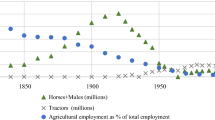Abstract
``Civic agriculture'' identifies adiverse and growing body of food and farmingenterprises fitted to the needs of localgrowers, consumers, rural economies, andcommunities. The term lends shape andlegitimacy to development paradigms that existin opposition to the global,corporately-dominated food system. Civicagriculture also widens the scope of ag-relatedconcerns, moving away from a strictlymechanistic focus on production and capitalefficiency, and toward the more holisticreintegration of people in place. To date,researchers and practitioners have attendedclosely to the economic benefits of newmarketing arrangements and institutions (e.g.,value-added co-ops, CSAs, and farmer'smarkets). Local food and farming has a criticalrole to play in the development of analternative commerce. At the same time, this isonly half the promise of civic agriculture.Civic agriculture can (and should) promotecitizenship and environmentalism within bothrural and urban settings not only throughmarket-based models of economic behavior, butthrough common ties to place and physicalengagement with that place.
Similar content being viewed by others
References
Bellah, R. N., R. Madsen, W. M. Sullivan, A. Swidler, and S. M. Tipton (1985). Habits of the Heart: Individualism and Commitment in American Life. New York: Harper & Roe.
Berry, W. (1990). What Are People for? San Francisco: North Point Press.
Boyte, H. and N. N. Kari (1996). Building America: The Democratic Promise of Public Work. Philadelphia: Temple University Press.
Cajete, G. (1993). “An enchanted land: Spiritual ecology and a theology of place.” Winds of Change Spring: 50-53.
Donahue, B. (1999). Reclaiming the Commons: Community Farms and Forests in a New England Town. NewHaven: Yale University Press.
Esteva, G. and M. S. Prakash (1998). “Beyond the individual self: Regenerating ourselves.” In Grassroots Post-Modernism: Remaking the Soil of Cultures (Chapter 3). London: Zed Books/New York: St. Martins Press.
Gabriel, Y. and T. Lang (1995). The Unmanageable Consumer: Contemporary Consumption and Its Fragmentation. London: Sage Press.
Goldschmidt, W. (1978). As You Sow. Allanheld, Montclair: Osum and Co.
Hynes, H. P. (1996). A Patch of Eden: America's Inner-city Gardens White River Junction. Chelsea Green Publishing Company.
Ikerd, J. (2001). “Reconnecting consumers and farmers in the food system.” A paper presented at Reconnecting Consumers and Farmers Conference, sponsored by Citizens Policy Center, Innovative Farmers of Ohio and Ohio Citizens Action, Columbus, Ohio, March 24.
Kemmis, D. (1990). Community and the Politics of Place. Norman: University of Oklahoma Press.
Kirschenmann, F. (1997). “On Becoming Lovers of the Soil.” In J. P. Madden and S. G. Chaplow (eds.), For All Generations: Making World Agriculture More Sustainable (pp. 101–114). Glendale, California: World Sustainable Agriculture Association.
Light, A. (2001). “Elegy for a garden: Thoughts on an urban environmental ethic.” Philosophical Writings 14: na.
Lyson, T. (2000). “Moving toward civic agriculture.” Choices (third quarter): 42-45.
Payne, K. and D. Fryman (2001). Cultivating Community: Principles and Practices for Community Gardening as a Community-Building Tool. American Gardening Association.
Schwartz, D. M. (1997). “A gift of a garden.” Smithsonian (September): 67-71.
Sclove, R. E. (2000). “Counter the cybernetic Wal-Mart effect.” Loka Institute. <sclove@loka.org>.
Shuman, M. (1998). Going Local: Creating Self-Reliant Communities in a Global Age. New York: Routledge.
Snyder, G. (1995). The Rediscovery of Turtle Island in a Place in Space. Washington, DC: Counterpoint.
Stauber, J. and S. Rampton (1995). Toxic Sludge is Good for You!: Lies, Damn Lies and the Public Relations Industry. Monroe, Maine: Common Courage Press.
Tolbert, C. M., T. A. Lyson, and M. D. Irwin (1998). “Local capitalism, civic engagement, and socioeconomic well-being.” Social Forces 77(2): 401–428.
Author information
Authors and Affiliations
Rights and permissions
About this article
Cite this article
DeLind, L.B. Place, work, and civic agriculture: Common fields for cultivation. Agriculture and Human Values 19, 217–224 (2002). https://doi.org/10.1023/A:1019994728252
Issue Date:
DOI: https://doi.org/10.1023/A:1019994728252




